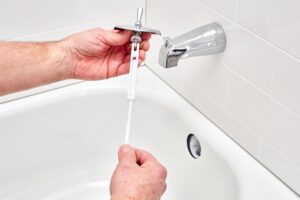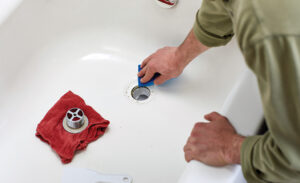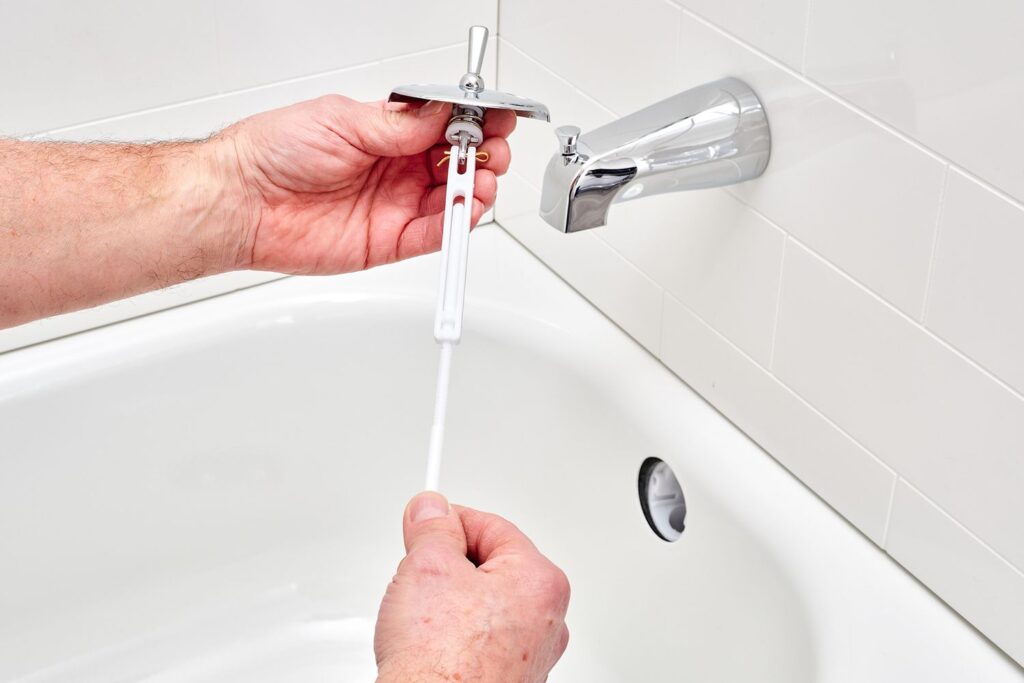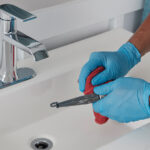Bathtub trip lever not working | Get solution A bathtub trip lever is a crucial part of your tub’s drainage system, allowing you to control the drain stopper with a lever mechanism. When it fails, it can result in an inability to hold water in the tub or to drain it properly.
Understanding the common issues and their solutions can save you from hiring a plumber. Here’s a detailed guide on troubleshooting and fixing a bathtub trip lever.

How the Bathtub Trip Lever Works
The trip lever mechanism typically consists of:
- Trip Lever Plate: The external plate with a lever or knob, usually found above the overflow drain.
- Linkage Rod: A rod or chain connected to the lever inside the overflow tube.
- Plunger: A stopper that moves up and down to open or close the drain.
Common Issues with a Bathtub Trip Lever
- Stuck Plunger: Over time, debris or corrosion can cause the plunger to stick, preventing it from moving smoothly.
- Broken or Disconnected Linkage: The linkage connecting the lever to the plunger can break or disconnect.
- Faulty Lever Mechanism: The external lever can become loose, stripped, or broken.
- Clogged Drain: Hair, soap scum, and other debris can clog the drain, making it difficult for the plunger to function properly.
Step-by-Step Guide to Fixing a Bathtub Trip Lever
Tools and Materials Needed
- Screwdriver (Phillips or flathead)
- Pliers
- Plumber’s tape
- Replacement parts (if necessary)
- Bucket or container
- Vinegar and baking soda (for cleaning)
- Pipe brush or old toothbrush
- Diagnose the Problem
- Check the Lever: Move the lever up and down to see if it feels loose or if there’s any resistance. If it moves freely without affecting the drain, the linkage might be broken or disconnected.
- Inspect the Drain: Look inside the tub drain to see if water is draining properly. If it’s slow, you might have a clogged drain in addition to trip lever issues.
2. Remove the Trip Lever Plate
- Unscrew the Plate: Use the appropriate screwdriver to remove the screws holding the trip lever plate in place.
- Pull Out the Assembly: Gently pull the plate away from the tub, bringing the linkage and plunger assembly with it.

3. Inspect and Clean the Components
- Check for Damage: Examine the linkage rod and plunger for any signs of damage or corrosion. If the rod is broken or severely corroded, it will need to be replaced.
- Clean the Plunger: Use a mixture of vinegar and baking soda to clean the plunger and linkage. Soak them in the solution for about 30 minutes to remove any buildup.
- Scrub the Tubing: Use a pipe brush or old toothbrush to clean inside the overflow tube. Ensure all debris is removed.
4.Repair or Replace Damaged Parts
- Replace Linkage Rod: If the rod is damaged, purchase a replacement from a hardware store. Make sure it matches the length and style of the old rod.
- Fix or Replace the Plunger: If the plunger is corroded or damaged, replace it with a new one.
5. Reassemble the Trip Lever Mechanism
- Attach the Linkage to the Lever: Reattach the linkage rod to the trip lever mechanism.
- Test the Plunger: Move the lever up and down to ensure the plunger moves freely.
- Reinsert the Assembly: Carefully reinsert the linkage and plunger into the overflow tube, making sure it’s aligned correctly.
6. Reattach the Trip Lever Plate
- Screw the Plate Back In: Secure the trip lever plate back to the tub using the screws you removed earlier.
- Test the Lever: Move the lever to see if it operates the drain stopper correctly. If the lever feels loose, you may need to tighten the screws or adjust the linkage.
7. Check for Leaks and Proper Operation
- Fill the Tub: Fill the tub with water to test the stopper’s ability to hold water.
- Drain the Tub: Move the lever to drain the water, ensuring it drains smoothly and quickly.
- Check for Leaks: Inspect the overflow tube and drain area for any signs of leaks. Tighten connections if necessary.
Preventative Maintenance
- Regular Cleaning: Clean the overflow tube and drain regularly to prevent buildup of debris and soap scum.
- Lubricate Moving Parts: Periodically lubricate the lever mechanism and linkage to ensure smooth operation.
- Inspect Components: Regularly check the linkage and plunger for signs of wear and tear.
Conclusion
Fixing a bathtub trip lever can seem daunting, but with a bit of patience and the right tools, you can tackle most issues on your own. By understanding the mechanism, diagnosing the problem, and following the steps outlined, you can restore your tub’s functionality without the need for professional help. Regular maintenance can also prevent future issues, keeping your bathtub in good working order for years to come.
Read Also. What is a Piggyback Breaker and Advantages & Types


